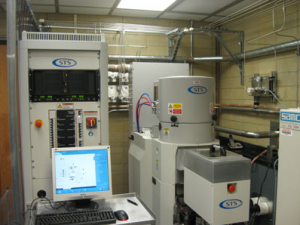 The Deep Reactive Ion Etcher (DRIE) uses a patented process to etch 3D features into silicon wafers. This allows users to create micro and nano-scale silicon-based devices ranging from probe tips to sensors to optical coatings. Unlike other etching processes, the DRIE is capable of creating very high aspect ratio structures without impacting the surrounding area, and doing so at incredibly fast rates.
The Deep Reactive Ion Etcher (DRIE) uses a patented process to etch 3D features into silicon wafers. This allows users to create micro and nano-scale silicon-based devices ranging from probe tips to sensors to optical coatings. Unlike other etching processes, the DRIE is capable of creating very high aspect ratio structures without impacting the surrounding area, and doing so at incredibly fast rates.
As with many instruments in the SHyNE facilities, the DRIE draws many external and internal users to perform nanoscale research. Internal users include Northwestern University’s Rogers, Stupp, Mohseni, Schatz, Odom and Dravid groups. External users include Advanced Diamond Technologies and Rubicon Technology.

With its capabilities in creating 3D structures, the DRIE has produced:
- New types of electrical devices made from diamond, biomedical sensors that will be used to reduce surgical deaths in children and provide real-time health information to professional athletes.
- Optical devices that have the potential to be used in next-generation television displays.
- Optical coatings that allow phone displays with nearly zero light reflection, while also repelling water, dirt and fingerprints.
 John Ciraldo is the Research Associate for Northwestern University’s Micro/Nano Fabrication Facility (NUFAB). He has a nanotechnology background in spintronics, an area of applied physics that aims to use electrons’ individual spin states to store and manipulate data, and has worked in the industry to develop new materials and semiconductor device technology. As Research Associate, Ciraldo trains new users, provides technical assistance for users, and maintains the instruments’ working conditions. John Ciraldo has been with Northwestern for six months and when he is not working in NUFAB, he is at home with his one and a half and two and a half year-old boys.
John Ciraldo is the Research Associate for Northwestern University’s Micro/Nano Fabrication Facility (NUFAB). He has a nanotechnology background in spintronics, an area of applied physics that aims to use electrons’ individual spin states to store and manipulate data, and has worked in the industry to develop new materials and semiconductor device technology. As Research Associate, Ciraldo trains new users, provides technical assistance for users, and maintains the instruments’ working conditions. John Ciraldo has been with Northwestern for six months and when he is not working in NUFAB, he is at home with his one and a half and two and a half year-old boys.
If you are interested in using the Deep Reactive Ion Etcher (DRIE) – STS LpX Pegasus, please contact Ben Myers at shyne@northwestern.edu or (847) 467-1081.